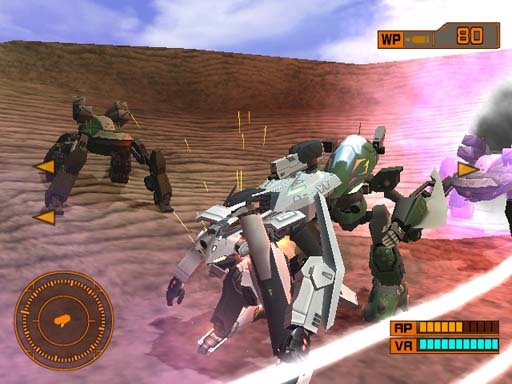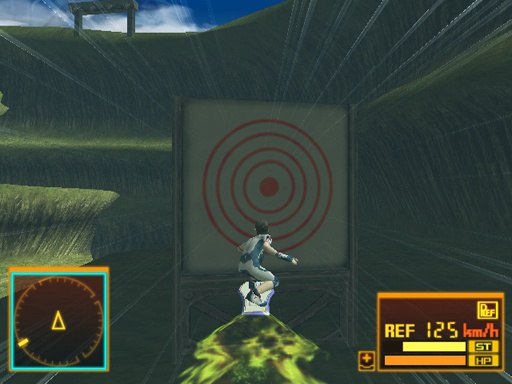Eureka Seven - Vol. 1: The New Wave is a prequel of sorts to the moderately popular anime and manga series Eureka Seven. However, be warned that other than a few oblique cameos by Holland and Moondoggie, the main cast of the show and books won't be the focus of the game. So if your only interest lies in the exploits of Renton and Eureka, here is not the place to look. Since there's not much gameplay, and not much to the gameplay, it will take an extreme, undying love of the source material to get anything positive from this lackluster effort.

You'll primarily follow Sumner Sturgeon, a sheltered young man who transfers from a military officer's training program to the New Wave Academy, which specializes in training LFO pilots. LFOs are the giant mech suits you'll pilot and do battle against. The storyline itself is rather lame and follows all the standard conventions of a teenybopper coming-of-age awkward-romance action drama that only anime can pull off with any modicum of success. You know, shy new kid with amazing talents falls in love with equally talented yet strikingly outspoken girl. Boy loses contact with girl, undergoes maturation process while defeating rivals, and finishes top of his class. Boy enters real world and makes a name for himself, while still being obsessed with the one that got away. Boy eventually meets back up with girl, girl inspires self-realization moment, boy betrays all he knows to make monumental contribution to rebel faction to impress girl. It's really quite daft, but it does have a hopeless romantic appeal, so if you're into these types of anime storylines, you'll probably find it touching. If you make it all the way through, you won't come across any startling revelations, and the action as it pertains to the anime series is mostly found in the fifth and final episode. Overall, the game serves to fill in some backstory and to establish a starting point for the next game in the series.
The nauseating nature of Eureka Seven's storyline could be forgiven were it not for the absolutely inconsistent way in which it is told. Since the game resembles an interactive anime more than anything else, you'll spend more time watching cinematics than playing the game. However, instead of choosing a clean, standardized way of doing this, the developer decided to mix things up by randomly fluctuating between high-res and low-res sequences, as well as spoken dialogue and text boxes. There seems to be neither rhyme nor reason to which way a sequence will go. It doesn't stop there, however, because most of the text boxes will scroll continuously, and for whatever reason you'll occasionally be prompted to hit a button to keep them going. At least one thing is consistent, though--that being the amount of time a text box displays its information. A box with lots of text appears and is gone as quickly as a box with little text. This can get extremely frustrating if you're actually interested in the story, because you'll occasionally be unable to finish reading a box before it's gone, and there's no way to see it again, aside from reloading from your last save point. Also, you'll see far too many loading screens, which will even break up two or more consecutive cinematic sequences. It's especially awesome when you save, watch three cinematic sequences in a row, with a load screen between each, and then are prompted to save again. Oddly enough, these save screens and occasional manual breaks in the dialogue are often a blessing, as it finally affords you time to take a break. There is no way to pause the cinematics, which is really a huge hassle since they are in such abundance.
What else is odd about these cinematics is that they remove the need for you to explore your environment, as the only time you're actually playing the game is during enclosed battles or races. Occasionally you'll be given free rein to explore an area of town or talk to people, but there's nothing in these environments that is superfluous, so when these occasions do arise, they feel odd and out of place, as if it would have just been better to stick with the cinematic format. Because there are so many cinematics and because it seems like the parts you do play are mostly training exercises, in both fighting and lifting, you'll often get the feeling that your actions are inconsequential.
It's almost for the better that there isn't much actual gameplay, because for the most part what's here isn't very good. The vast majority of the missions deal with scintillating mech-on-mech action. Here, you'll fight alone or with a teammate in mostly confined arenas against enemy LFOs and tanklike missile launchers. Robot mode is the one best equipped for fighting, and you'll be able to boost your jets to sprint and jump, as well as change directions on a dime. You'll have a few ways to wreck other robots in this mode, each of which has its strengths and weaknesses. Jamming on the melee button and pressing a direction on the D pad lets you flail about with attack combos in close quarters, and this is the best way to do serious damage. However, most opponents are pretty good at blocking, and if you're fighting multiple enemies, fixating on one for an extended period is a good way to get yourself creamed by your target's buddies. LFOs are also equipped with boomerang knives. This attack doesn't do much damage, but it is a good way to stop enemies in their tracks by knocking them down. You'll also have a ranged attack, which is perhaps the most useful of the bunch. Weapons range from railguns to rocket launchers, and you'll be able to buy bigger and better versions as you progress through the game. As for vehicle mode, your speed is enhanced, but your offensive capabilities and general maneuverability are inhibited. Though you have a spinning attack that clips the legs out from under an enemy LFO, this attack does little damage and is comparable to the more reliable boomerang knives. Also, the shooting mechanic is the same as in robot mode, but locking on to an enemy isn't as reliable, so there's never a useful reason to be in this mode.
Lifting seems to be the natural evolution of hoverboarding, made popular by Marty McFly in the illustrious Back to the Future 2. Here, Sumner and his cohorts will race around circular tracks littered with obstacles while riding trapar waves, which give your board a speed boost. You'll be able to perform a limited number of tricks on these boards, such as 360 spins and flips, which are fairly easy to do and act to restore your ref-board's boost. However, trying to do tricks while racing all too often leads to your being completely turned around or suspended upside down, on the verge of plummeting to your doom, and it's never necessary to use these tricks to finish first in a race. Regardless, you'll be lifting only a handful of times throughout the game, so whether or not you get any good at it is immaterial. In the last of the five episodes, you'll finally get to throw down while surfing ref-boards in an LFO, but combat here is equally prone to button mashing and cheap tactics, and you'll be limited to the melee abilities of your LFO in the one battle that has any significance.
Mostly because he's of the naïve and trusting sort, Sumner occasionally finds himself facing a beating while outside his mech. Fighting here is functionally the same as when Sumner is in robot form. Much like the various weapon upgrades you'll be able to purchase for your mech, here you'll be able to purchase various firearms, including nonlethal impact guns, submachine guns, and sniper rifles. Fighting as Sumner is essentially a tame version of fighting in the mechs. It lacks the chaotic speed and fancy weaponry, so it really doesn't add much to the experience. Using firearms is as basic as it comes and boils down to locking on to a target and standing still while you shoot it until it's dead. Also, the artificial intelligence of enemies is extremely stupid, to the point of being mostly broken. Enemies will often get stuck behind crates, giving you free shots at them with a gun, and they'll completely ignore being shot if you're using the sniper rifle from afar. This game probably would have been significantly improved had Namco Bandai simply dropped the ability to fight as Sumner altogether and spent more time on fleshing out the mech-fighting mechanics.

The many cinematics are rendered through the game's engine, so the game lacks the clean lines and definition of prerendered animated cutscenes. However, Eureka Seven does look pretty good for a late arrival on an outdated system. Characters animate fairly well, albeit a bit unnaturally at times; they're somewhat expressive with their facial features; and they move their lips in time with the dialogue for the most part. The frame rate does drop off significantly when several mechs are onscreen and battling it out, but the negative effects of this are only minor. The voice acting has the melodramatic flair that you'd expect from an anime of this type. It would have been nice had the entire game been voiced, for the sake of consistency if nothing else, but that is sadly not the case. The game also features a stereotypical anime backdrop of synthetic pop, which may or may not make your ears bleed after prolonged exposure.
Plain and simple, Eureka Seven - Vol. 1: The New Wave places its story above all else, so if you aren't interested in the characters it presents, you'll be extremely disappointed by this game. True, there is a situation mode, which lets you play out most of the missions without wading through the hours and hours of cinematics, but the fact remains that the gameplay simply isn't that good and certainly isn't enough to carry the experience on its own. Because the game doesn't deal explicitly with the primary characters of the anime, and because of the inconsistent presentation and various gameplay issues, it's just about impossible to recommend this game to anyone but the most unreasonably forgiving of Eureka Seven fans.